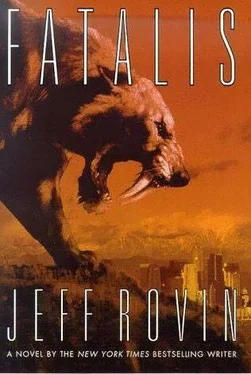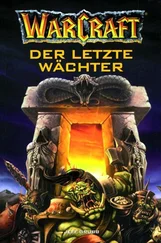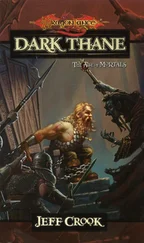Jeff Rovin - Fatalis
Здесь есть возможность читать онлайн «Jeff Rovin - Fatalis» весь текст электронной книги совершенно бесплатно (целиком полную версию без сокращений). В некоторых случаях можно слушать аудио, скачать через торрент в формате fb2 и присутствует краткое содержание. Жанр: Триллер, на английском языке. Описание произведения, (предисловие) а так же отзывы посетителей доступны на портале библиотеки ЛибКат.
- Название:Fatalis
- Автор:
- Жанр:
- Год:неизвестен
- ISBN:нет данных
- Рейтинг книги:3 / 5. Голосов: 1
-
Избранное:Добавить в избранное
- Отзывы:
-
Ваша оценка:
- 60
- 1
- 2
- 3
- 4
- 5
Fatalis: краткое содержание, описание и аннотация
Предлагаем к чтению аннотацию, описание, краткое содержание или предисловие (зависит от того, что написал сам автор книги «Fatalis»). Если вы не нашли необходимую информацию о книге — напишите в комментариях, мы постараемся отыскать её.
Fatalis — читать онлайн бесплатно полную книгу (весь текст) целиком
Ниже представлен текст книги, разбитый по страницам. Система сохранения места последней прочитанной страницы, позволяет с удобством читать онлайн бесплатно книгу «Fatalis», без необходимости каждый раз заново искать на чём Вы остановились. Поставьте закладку, и сможете в любой момент перейти на страницу, на которой закончили чтение.
Интервал:
Закладка:
"They couldn't have," Grand said. He sat back down.
"Why not?"
"Because we don't have any fur samples from saber-tooths."
"You don't, but someone may."
"I mean scientists don't have any samples," Grand told Hannah. "We've found swatches of fur from woolly rhinoceroses, woolly mammoths, peccaries, short-faced bears, snowshoe hares, dire wolves, and giant sloths. We've got fur, skin, and even organ samples from all kinds of prehistoric mammals from around the world, samples that were frozen in ice or submerged in tar. But we've never found any specimens of fur from a saber-toothed cat. We haven't even found a cave painting that shows a saber-toothed cat."
"Why do you think that is?"
"Probably because no one who ever saw one lived to paint its picture," Grand said. "From everything we can gather-including computer simulations based on skeletal remains-saber-tooths were the greatest hunters that ever lived. Fast, stealthy, powerful. As for why there are no fur samples, we suspect that most of the cats died in open fields where they probably hunted, and that their remains were scavenged by animals or early humans for food, clothing, and weapons. Their fangs would have made excellent knives."
"Good point," Hannah said. "No pun intended. So if our knowledge is so thin, where did the original DNA sample for your fatalis tiger come from?"
"We got that from bone and tooth fossils," Grand said. "The fossilization record has left a very clear imprint of saber-tooth DNA."
"I see. Then maybe someone used that DNA to genetically engineer fake hair," Hannah suggested.
"Why?"
"I don't know," Hannah admitted.
"It would take tens of millions of dollars and a very sophisticated lab to fake something this convincing," Grand told her.
"Besides, if someone did that they'd probably want to make the discovery themselves, get the acclaim and funding that comes with it."
"True," she admitted.
They were silent for a moment Grand couldn't stop thinking about Haphap , about Tumamait's utter conviction, about the caves, about the presence he felt when he was down there. Chumash lore did not describe Haphap . Perhaps the demon was meant to personify everyone's greatest fear. Or maybe he was never seen clearly in visions.
Or perhaps the stories came from real life?
The legends about Haphap could have risen from tales of a fearsome predator that lived inside the mountain caverns and struck swiftly and terribly. And if that were true-
"I wonder," Grand said.
"About what?"
"The caves," he said. "I wonder if there might not be another reason we never found any saber-tooth fur."
"Such as?"
"Maybe they lived and died underground," Grand said. "Bobcats live in dens. Foxes make their homes in underground burrows. Bats roost in caves. Early humans dwelt there as well."
"Sounds reasonable."
"Even more so when you consider that the cats may have gone underground when things froze up during the Ice Age," Grand said. "Generations of them living in caves. And when saber-tooths migrated south, where it was warmer, they stayed in the caves."
"No one ever thought of this before?"
"Not that I'm aware of," Grand said. "Paleontologists believe strongly in 'habitual parallelism,' an assumption that the lifestyles of past and present species are somewhat similar. Ancient turtles lived the same way as modem turtles, ancient birds lived like modern birds, and so on. We've always assumed that saber-tooths were like modern-day lions and tigers. But what if they weren't? What if we haven't seen any paintings of them because, like bats, like many other predators, they hunted at night when prehistoric people were in their huts or caves."
"That makes sense," Hannah said. "But how does that help us? Are you suggesting that a species could have survived unseen for thousands of years?"
"No," Grand said. "I'm just thinking out loud, looking for new ideas, directions."
Grand turned to the keyboard and checked for the results of the gas chromatography tests on the rock scrapings he'd taken. The computer at the lab told him the tests were still working. He sat in silence, staring at the DNA maps, doing what a man does if he hasn't had an epiphany in the form of a vision. Wrestling with science and spirit.
"The Flintstones," Hannah said softly.
"Excuse me?"
"First instincts," she said. "I always thought they were a little crazy but now I'm not so sure. Let me ask you something. Forget about it being 'impossible' for the moment. Is there any way you can imagine that one of these saber-toothed tigers might have survived?"
"Any way I can imagine it?"
"Yes," Hannah said. "Like they do in Scotland with the Loch Ness Monster. Do you believe in the Loch Ness Monster?"
"I'm not convinced that it exists."
"But you don't rule out the possibility."
"No."
"Or the Abominable Snowman."
"Where's this going?" Grand asked.
"What if we start from that same place with the saber-tooths?" Hannah asked. "With a possibility, however remote. When I toured Loch Ness, the guide on the boat said things like, 'Ages ago the Loch was closed off from the North Sea and a family of prehistoric animals could have been trapped here… and so on and so forth.' Assume we have a saber-toothed tiger. It certainly seems to fit the profile of our killer. How did it get here?"
Grand shook his head. "First of all, any species with just one living example couldn't survive. There would have to be parents and offspring."
Hannah shrugged. "If we can allow one saber-toothed tiger then we can allow two. Just like in Loch Ness."
"I suppose so," Grand said. "But even if there were a pair of specimens and they lived in caves and only came out at night, there would be some evidence of habitation. Feces. Carcasses of prey."
"Maybe they live deep in the caves or defecate in underground streams," Hannah said. "Maybe they bury the bones like dogs or maybe they eat the bones as well as the meat."
"That's a lot of maybes, Hannah."
"I know," she admitted. "I don't like them either. But let's keep going. How much would these creatures eat?"
"A modern lion, in captivity, needs about twenty-five pounds of raw meat each day," Grand said. "In the wild, where it needs energy to hunt, a lion consumes thirty to forty pounds of meat a day. And that's a four- or five-hundred pound animal, six or seven feet long. Smilodon fatalis weighed from fifty to one hundred pounds more than that on average."
As they were talking, the gas chromatography analysis of the cave scrapings arrived.
Grand immediately opened the file to have a look while Hannah tapped her leg anxiously. She was as intense a person as Grand had ever met. Even in the middle of this-or because they were in the middle of it?-he found it invigorating.
"Talk to me," Hannah said. "What have we got?"
"Another piece to the puzzle that doesn't seem to fit," Grand said. "The rock scrapings from the cave where I found the hair were laced with tephra residue-volcanic ash. There are also significant traces of silicate glass, sulfur, chlorine, aluminum, and sodium and other minerals that, according to the report, are not indigenous to this region."
"Translation, please."
"The mountain passageways could be vents for local volcanic activity or for volcanoes that erupted hundreds of miles away," Grand said. "That would account for some of those elements."
"They got blasted here."
"Right. What I can't understand is the presence of minerals I've only seen in artifacts from the far north."
"Which means?"
Grand sat back and folded his arms. "Stone and wood that have been buried in glaciers become permeated with the waters that comprise the ice," he said. "They have a distinctive chemical signature. We didn't have glaciers this far south, but what we've got here are the same chemical signatures."
Читать дальшеИнтервал:
Закладка:
Похожие книги на «Fatalis»
Представляем Вашему вниманию похожие книги на «Fatalis» списком для выбора. Мы отобрали схожую по названию и смыслу литературу в надежде предоставить читателям больше вариантов отыскать новые, интересные, ещё непрочитанные произведения.
Обсуждение, отзывы о книге «Fatalis» и просто собственные мнения читателей. Оставьте ваши комментарии, напишите, что Вы думаете о произведении, его смысле или главных героях. Укажите что конкретно понравилось, а что нет, и почему Вы так считаете.












